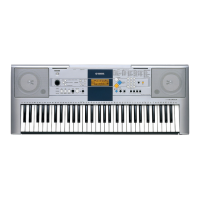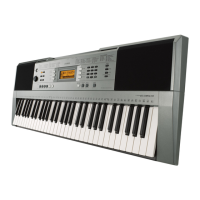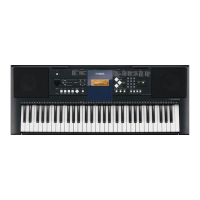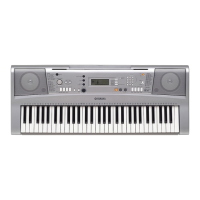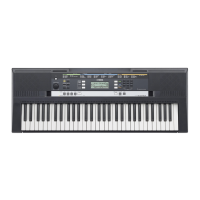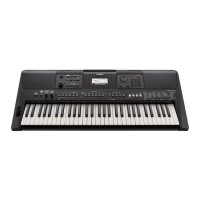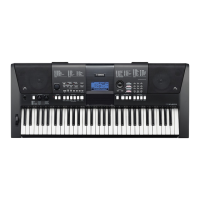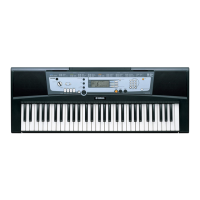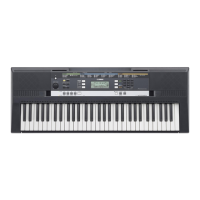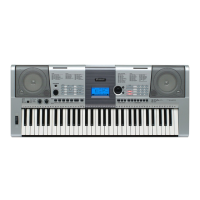Do you have a question about the Yamaha PSR-E360 and is the answer not in the manual?
Important warnings, specifications, notices, and environmental considerations for safe product use.
Guidelines for battery usage, replacement, and proper disposal of the instrument.
Information on locating the product's name plate for model and serial number details.
Notices regarding FCC compliance, modifications, cable usage, and potential electronic interference.
Supplier's declaration of conformity to FCC rules, ensuring proper operation without harmful interference.
Explains the meaning of graphical symbols used in the manual, such as danger and exclamation marks.
Comprehensive safety instructions for operating the instrument and AC adaptor to prevent electrical shock and damage.
Specific safety warnings and cautions related to the use and setup of the AC adaptor.
Critical warnings for instrument usage, including power supply, water exposure, and fire hazards.
Detailed precautions for battery installation, usage, and handling to prevent explosions, fire, or leakage.
General cautions for handling the instrument, including power supply, location, connections, and physical interaction.
Notices regarding handling, cleaning, and saving instrument data to prevent malfunctions and data loss.
Information on copyright laws, bundled content usage, and notes about the manual's illustrations and product names.
Details about the included Owner's Manual and downloadable online materials like Drum Kit List and Song Book.
Lists the accessories included with the digital keyboard, such as the AC adaptor and music rest.
Instructions on how to properly attach the music rest to the instrument.
Identifies and describes the various controls and buttons located on the front panel of the instrument.
Identifies and describes the terminals and jacks located on the rear panel of the instrument.
Discusses power source options, recommending AC adaptor over batteries for environmental and resource reasons.
Instructions for connecting the AC adaptor to the instrument and power outlet for operation.
Guidelines for installing and using batteries as a power source for the instrument.
Instructions on how to set the instrument's battery type to ensure optimal battery life.
Step-by-step guide on turning the instrument on and off, including standby mode operation.
Explains how to use and disable the Auto Power Off function to prevent unnecessary power consumption.
Details the various items displayed on the instrument's screen, such as notation, chords, and status indicators.
Explains basic operations using number buttons and +/- buttons for selecting items and changing values.
Guide to selecting voices, using the Grand Piano feature, and operating the metronome for practice.
Explains features to enhance sound, including sustain, touch response, ultra-wide stereo, and effects.
Step-by-step guide on activating the Duo mode for simultaneous playing by two people.
Details on selecting voices and how sound is outputted from speakers in Duo mode.
Explains sustain usage and style playback limitations within the Duo mode.
Information on phrase recording capabilities and considerations within the Duo mode.
Covers listening to demo songs, selecting and playing back songs, and BGM playback options.
Details transport controls, tempo adjustment, tap function, A-B repeat, and part control.
Instructions on changing the melody voice of a song.
Explains the three lesson modes: Listen & Learn, Timing, and Waiting, for practicing songs.
Guide on selecting songs and practicing with left-hand, right-hand, or both-hands lessons.
How to play and listen to songs designed to learn individual chords.
How to play and listen to songs that demonstrate basic chord progressions.
Guide to selecting styles, starting/stopping playback, and rhythm-only playback.
Covers adjusting style volume, tempo, and understanding style section variations like Intro, Main, and Ending.
A chart and explanation of common chord types and how to play them for auto accompaniment.
Steps to prepare for recording, including selecting voices and enabling the record mode.
Details on limitations during recording, including unavailable settings and features.
Instructions on stopping the recording process and playing back the recorded user song.
Describes the different Master Equalizer (EQ) settings available and their effects on the sound output.
Guide on connecting external audio devices like music players to the instrument for playback through its speakers.
Instructions for connecting headphones or external speakers to the instrument's output jack.
Instructions on connecting and using a footswitch for sustain effect, including notes on compatibility.
Lists the instrument settings that are maintained even when the power is turned off.
Step-by-step guide on how to initialize the instrument's backup data to factory default settings.
Provides a comprehensive list of instrument functions, their settings, ranges, and descriptions for customization.
Important warnings, specifications, notices, and environmental considerations for safe product use.
Guidelines for battery usage, replacement, and proper disposal of the instrument.
Information on locating the product's name plate for model and serial number details.
Notices regarding FCC compliance, modifications, cable usage, and potential electronic interference.
Supplier's declaration of conformity to FCC rules, ensuring proper operation without harmful interference.
Explains the meaning of graphical symbols used in the manual, such as danger and exclamation marks.
Comprehensive safety instructions for operating the instrument and AC adaptor to prevent electrical shock and damage.
Specific safety warnings and cautions related to the use and setup of the AC adaptor.
Critical warnings for instrument usage, including power supply, water exposure, and fire hazards.
Detailed precautions for battery installation, usage, and handling to prevent explosions, fire, or leakage.
General cautions for handling the instrument, including power supply, location, connections, and physical interaction.
Notices regarding handling, cleaning, and saving instrument data to prevent malfunctions and data loss.
Information on copyright laws, bundled content usage, and notes about the manual's illustrations and product names.
Details about the included Owner's Manual and downloadable online materials like Drum Kit List and Song Book.
Lists the accessories included with the digital keyboard, such as the AC adaptor and music rest.
Instructions on how to properly attach the music rest to the instrument.
Identifies and describes the various controls and buttons located on the front panel of the instrument.
Identifies and describes the terminals and jacks located on the rear panel of the instrument.
Discusses power source options, recommending AC adaptor over batteries for environmental and resource reasons.
Instructions for connecting the AC adaptor to the instrument and power outlet for operation.
Guidelines for installing and using batteries as a power source for the instrument.
Instructions on how to set the instrument's battery type to ensure optimal battery life.
Step-by-step guide on turning the instrument on and off, including standby mode operation.
Explains how to use and disable the Auto Power Off function to prevent unnecessary power consumption.
Details the various items displayed on the instrument's screen, such as notation, chords, and status indicators.
Explains basic operations using number buttons and +/- buttons for selecting items and changing values.
Guide to selecting voices, using the Grand Piano feature, and operating the metronome for practice.
Explains features to enhance sound, including sustain, touch response, ultra-wide stereo, and effects.
Step-by-step guide on activating the Duo mode for simultaneous playing by two people.
Details on selecting voices and how sound is outputted from speakers in Duo mode.
Explains sustain usage and style playback limitations within the Duo mode.
Information on phrase recording capabilities and considerations within the Duo mode.
Covers listening to demo songs, selecting and playing back songs, and BGM playback options.
Details transport controls, tempo adjustment, tap function, A-B repeat, and part control.
Instructions on changing the melody voice of a song.
Explains the three lesson modes: Listen & Learn, Timing, and Waiting, for practicing songs.
Guide on selecting songs and practicing with left-hand, right-hand, or both-hands lessons.
How to play and listen to songs designed to learn individual chords.
How to play and listen to songs that demonstrate basic chord progressions.
Guide to selecting styles, starting/stopping playback, and rhythm-only playback.
Covers adjusting style volume, tempo, and understanding style section variations like Intro, Main, and Ending.
A chart and explanation of common chord types and how to play them for auto accompaniment.
Steps to prepare for recording, including selecting voices and enabling the record mode.
Details on limitations during recording, including unavailable settings and features.
Instructions on stopping the recording process and playing back the recorded user song.
Describes the different Master Equalizer (EQ) settings available and their effects on the sound output.
Guide on connecting external audio devices like music players to the instrument for playback through its speakers.
Instructions for connecting headphones or external speakers to the instrument's output jack.
Instructions on connecting and using a footswitch for sustain effect, including notes on compatibility.
Lists the instrument settings that are maintained even when the power is turned off.
Step-by-step guide on how to initialize the instrument's backup data to factory default settings.
Provides a comprehensive list of instrument functions, their settings, ranges, and descriptions for customization.
| Keyboard | 61 keys |
|---|---|
| Polyphony | 32 notes |
| Amplifiers | 2.5W + 2.5W |
| Speakers | 12 cm x 2 |
| Touch Response | Yes |
| Display | LCD |
| USB to Host | Yes |
| Voices | 574 voices |
| Styles | 165 styles |
| Weight | 4.6 kg |
| Power Supply | PA-130 or batteries |
| Headphones | Yes |
| Aux In | Yes |
| Effects | Reverb, Chorus |
| Connections | DC IN, Headphones, AUX IN, Sustain Pedal |
| Included Accessories | Music Rest |
| Dimensions | 945 mm (37-3/16") x 118 mm (4-5/8") x 368 mm (14-1/2") |
